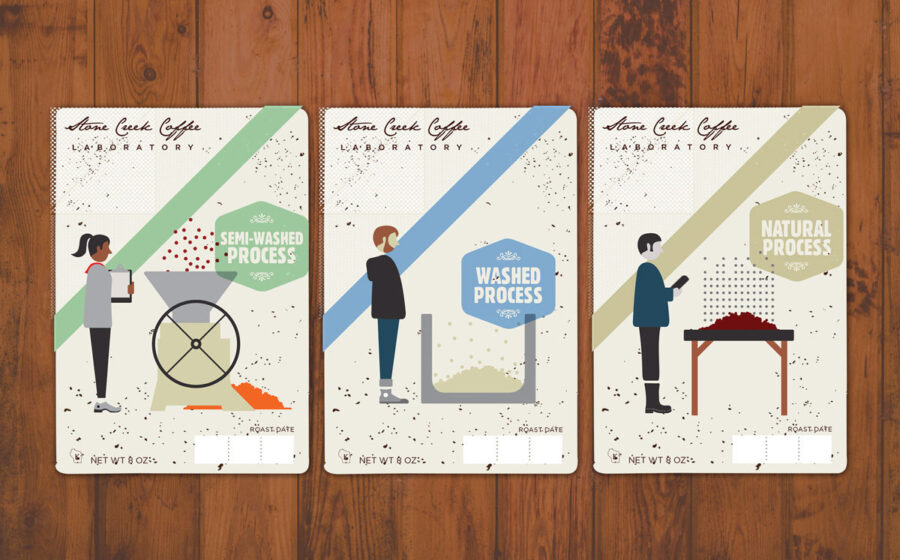[I]f you ask most of my extended family, they’d tell you that coffee is just coffee, a bitter brew that you need to put cream in (ideally, flavored cream). My family also believes it’s not worth paying more than the sale price at the grocery store. That’s the attitude of a lot of folks in the Midwest, where I reside. And in truth, many things in the coffee industry remain a mystery to the consumer, even something as seemingly simple as roast level.
We roasters don’t always seem to acknowledge this confusion.
We cram labels full of information including altitude, variety, processing, cupping notes, harvest date, and so on. How many of our customers really understand how these variables affect the taste of the final cup? How many of us actually take the time to explain the processes? With this many variables it’s easy to understand why most consumers know very little about each.
We are working on new case studies built around such variables as altitude, aerobic fermentation, anaerobic fermentation, and color of the cherry when picked.
I work for Stone Creek Coffee in Milwaukee as the director of coffee and green buyer. In my six years in the coffee industry, I’ve had many opportunities to cup at origin with producers in Latin America. (Clearly, I’m still a bit of a newbie in the context of our industry, and I look forward to cupping with our partner’s in Africa and the Pacific.) All of my cupping experiences have counted among the most meaningful moments of my coffee career. It’s your one real chance to give the producer feedback on the coffee she or he spent the majority of the year tilling, pruning, fertilizing, watering, picking, sorting, and processing. It’s also the time for me to see acutely how altitude, tree variety, and processing affect the final cup. However, something meaningful would be lost between the origin cupping and the cuppings with our baristas and consumers when we returned to Milwaukee. It was in this gap that we discovered our Case Study series of coffees.
Let me backtrack to January of 2014. I was visiting our friends Edgar and Estuardo Fallas at Finca San Sebastian in Antigua, Guatemala. We’d spent a good part of the day wandering the farm, seeing the wide variety of coffee they produce. While touring the mill and drying patios, I noticed they were experimenting with honey and natural processes. I was familiar with honey from my time in Costa Rica, but had never seen it done in Guatemala. I needed to know what that tasted like. It felt kind of random at the time, but I asked if we could have one coffee processed three different ways. The response was a pretty quick, “Yeah, sure! We can do that for you.”
A month or so later when we cupped these three coffees it was apparent that we had stumbled onto a very cool thing. The coffees came from the same micro region on the farm, a plot named Santo Domingo, but each cup—washed, semi-washed, and natural—had its own unique character. It didn’t take long for us to recognize our opportunity. Instead of making this an internal education tool, we decided to make this into a box set that could be accessible to all.
The set included a large, foldout infographic on coffee processing that gave consumers a brief and simple explanation on what happened with these coffees during the different processing methods. Finally, it contained information about Edgar and Estuardo’s meticulous operation. We followed this with a Case Study on honey process, showing how different producers from the same region of Costa Rica approach a single processing method.
I think consumers, even if they’ve wrapped their minds around light vs. dark roast, are often thrown off when hearing the terms “natural process” or “honey process.” By providing them a little experiment and giving them enough knowledge to have fun, this project allows customers to approach the mysterious aspects of coffee in a structured, low-stakes way.
When considering coffee one variable at a time, there are endless case studies to develop. We are working on new case studies built around such variables as altitude, aerobic fermentation, anaerobic fermentation, and color of the cherry when picked.
One of the main goals of our Case Study series is to promote transparency and education throughout the farm-to-cup process. As an example, in the Guatemala Case Study, where we explored the three different processes, we included a stamped post card so consumers could send us their feedback on which process and cup they liked best. I sent postcards back to Edgar at the farm. How often does a producer actually get to hear directly from the end consumer? It creates a dialogue and, in the end, a stronger connection between our producing friends at origin and our customers who sip their coffee each morning.
—Christian Ott is the director of coffee and green buyer at Stone Creek Coffee.
















